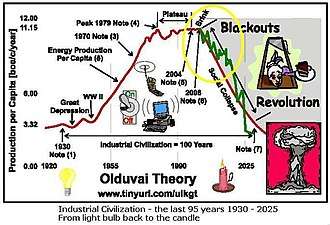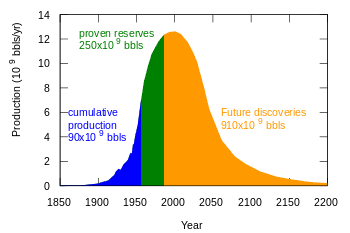Olduvai theory
The Olduvai theory is a 1989 theory postulated by Richard C. Duncan, which states that industrial civilization (as defined by per capita energy production) will have a lifetime of less than or equal to 100 years. The theory provides a quantitative basis of the transient-pulse theory of modern civilization. The name is a reference to the Olduvai Gorge in Tanzania.

History
The Olduvai theory was introduced in 1989 by power system engineer Richard C. Duncan as the "transient-pulse theory of industrial civilization"[1] with further details in the 1993 paper "The life-expectancy of industrial civilization: The decline to global equilibrium".[2]
In June, 1996, Duncan introduced a paper titled "The Olduvai Theory: Sliding Towards a Post-Industrial Stone Age" where the term "Olduvai Theory" replaced "transient-pulse theory" used in previous papers.[3] Duncan further updated his theory in "The Peak of World Oil Production and the Road to the Olduvai Gorge", at the Summit 2000 Pardee Keynote Symposium of the Geological Society of America, on November 13, 2000.[4] In 2005, Duncan extended his data set to include up to 2003 in "The Olduvai Theory Energy, Population, and Industrial Civilization".[5]
Details of theory
Industrial civilization is defined in Duncan's paper as the time between energy production per capita rising above 37% of its eventual peak value, and it falling back below 37% of the peak value later. In 1996, he estimated this period to be from 1930 until approximately 2025, with the per capita peak having occurred in 1977.[3] In 2009, he considered separately the peaks of standard of living in OECD countries, non-OECD countries (specifically China, India and Brazil), and the USA. He found that the standard of living in the US peaked in 1973, that of OECD countries in 2005, while that of the non-OECD countries was still rising in 2007. He predicted a global peak in standard of living in 2010, followed by a decline to the 1930 level by 2030.[5]
The Olduvai theory claims that exponential growth of energy production ended in 1979, that energy use per capita will show no growth through 2008, and that after 2008 energy growth will become sharply negative, culminating, after a Malthusian catastrophe, in a world population of 2 billion circa 2050. [5]
The Olduvai theory divides human history into three phases. The first "pre-industrial" phase stretches over most of human history when simple tools and weak machines limited economic growth. The second "industrial" phase encompasses modern industrial civilization where machines temporarily lift all limits to growth. The final "de-industrial" phase follows where industrial economies decline to a period of equilibrium with renewable resources and the natural environment.[4]
The decline of the industrial phase is broken into three sections:
- The Olduvai slope (1979–1999)—energy per capita 'declined at 0.33%/year'
- The Olduvai slide (2000–2011)—'begins … with the escalating warfare in the Middle East… marks the all-time peak of world oil production'.
- The Olduvai cliff (2012–2030)—'begins … in 2012 when an epidemic of permanent blackouts spreads worldwide, i.e. first there are waves of brownouts and temporary blackouts, then finally the electric power networks themselves expire'. This is partly connected to fossil fuel production, as coal and natural gas are significant fuel sources in electricity generation, but it is unclear how nuclear power generation fails, if at all.
Criticism
Data
At the time of Duncan's paper, the peak in per capita energy consumption was 11.15 boe/c/yr (barrels of oil equivalent per capita per year) and occurred in 1979; however, since then energy use per capita has increased beyond that level, with 2006 providing a peak value of 12.12 boe/c/yr.[6][7] This increase directly contradicts Postulate 2 of the most recent version of the theory, namely that "[average per capita energy] will show no growth from 1979 to circa 2008".[5] Duncan has responded to this criticism in a 2009 essay entitled The Olduvai Theory - Toward Re-Equalizing the World Standard of Living.[8] The response is that certain non-OPEC countries such as China and India have increased their per capita energy usage whilst efficiency improvements within the USA & OPEC have reduced their requirements for energy without impacting the quality of life. The theory is then re-assessed from the standpoint OPEC, non-OPEC and USA energy consumption.
Proponents note that the current trend of increasing per capita energy consumption may be difficult to sustain in the face of limits on fossil fuel resources such as oil, coal, and natural gas.[9] However, advances in renewable energy have reduced dependence on fossil fuels. For example, in 2015 Sweden produced approximately 8,153 kWh of electricity per capita per year (5.01 boe/c/yr) from renewable resources, with the exclusion of hydropower; Sweden's theoretical maximum electric generation capacity from renewable resources, including hydropower, is estimated to be 24,472 kWh per capita per year (15.03 boe/c/yr) at the current population level.[10]
Quote
In justification of his reference to Olduvai Gorge, Duncan writes:[11]
…(1) it is famous for the myriad hominid fossils and stone tools discovered there, (2) I've been there, (3) its long hollow sound is eerie and ominous, and (4) it is a good metaphor for the 'Stone Age way of life'.
See also
- Doomsday argument
- Future energy development
- Peak minerals
- Steady-state economy
- The Limits to Growth
- Great Depression
- Hubbert peak theory
- M. King Hubbert
- Myth of Progress
- Non-renewable resources
- Societal collapse
- White's law
References
- OT_1989.pdf - Duncan, R. C. (1989). Evolution, technology, and the natural environment: A unified theory of human history. Proceedings of the Annual Meeting, American Society of Engineering Educators: Science, Technology, & Society, 14B1-11 to 14B1-20.
- Duncan, R. C. (1993). The life-expectancy of industrial civilization: The decline to global equilibrium. Population and Environment, 14(4), 325-357.
- "The Olduvai Theory:Sliding Towards a Post-Industrial Stone Age Archived 2007-05-10 at the Wayback Machine - Richard C. Duncan (1996), www.dieoff.org
- "The Peak Of World Oil Production And The Road To The Olduvai Gorge" Archived 2009-06-24 at the Wayback Machine - Richard C. Duncan (2000), www.dieoff.org
- "The Olduvai Theory Energy, Population, and Industrial Civilization" - Richard C. Duncan (2005/2006), www.TheSocialContract.com
- World Per Capita Total Primary Energy Consumption, 1980-2006 Archived 2006-10-13 at the Wayback Machine - Energy Information Administration, 2006 (Excel Sheet)
- Energy Units and Conversions - Dennis Silverman, UC Irvine
- "The Olduvai Theory - Toward Re-Equalizing the World Standard of Living" - Duncan, R. C. (2009), www.TheSocialContract.com
- Revisiting the Olduvai Theory - The Oil Drum, March 6, 2006
- "Energy consumption in Sweden". WorldData.info. Eglitis-media. Retrieved 3 October 2018.
- Richard C. Duncan, World Energy Production, Population Growth, And the Road to the Olduvai Gorge, Institute on Energy and Man, As published in Population and Environment, May-June 2001, v. 22, n. 5. url Archived 2012-02-16 at the Wayback Machine
Further reading
- Ahlbrandt, Thomas S. (August 31, 2015). "From Petroleum Scarcity to Abundance: Opportunities and Implications for the U.S. and World". Search and Discovery.

- Allali, M.; Tamali, M. & Rahlic, M. (2018). "Algeria energy production, population growth based on Olduvai Theory" (PDF). Revue des Energies Renouvelables. 21 (3): 445–454. Archived from the original (PDF) on 2020-03-22. Retrieved 2020-03-16.

- Grīnberga, Līga; Kleperis, Jānis; Ribickis, Leonīds (June 24, 2008). "Publikācija: Why the Hydrogen Energy is Necessary for Latvia". Riga Technical University: 56–57.

- Leigh, James (2008). "Beyond Peak Oil in Post Globalization Civilization Clash". The Open Geography Journal. 1: 15–24. doi:10.2174/1874923200801010015.

- Leigh, James (June 24, 2008). "The Olduvai Theory and Catastrophic Consequences". Resilience.

External links
- The Olduvai Theory - Towards Re-Equalizing the World Standard of Living (PDF file) - Summer 2009, The Social Contract
- America - A Frog in the Kettle Slowly Coming to a Boil - Fall 2007, The Social Contract
- The Olduvai Theory - Terminal Decline Imminent - Spring 2007, The Social Contract
- World Energy Production, Population Growth, and the Road to the Olduvai Gorge - May 2001 (this was an invited presentation to the Pardee Keynote Symposia, GSA Summit 2000, Reno NV, Nov 13)
- M. King Hubbert on the Nature of Growth. 1974
- Olduvai Revisited 2008 (TheOilDrum)
- The Olduvai Theory of Industrial Civilization(less complete than the paper referenced above but updated more recently)
- dieoff.org
- "The Post-Petroleum Paradigm—and Population"- Walter Youngquist (1999)
- "Forecast of Oil and Gas Supply to 2050"- Jean Laherrere (2003) (PDF file)
- "2006 Long-Term Reliability Assessment" - North American Electric Reliability Council (NERC)
- The Imminent Collapse Of Industrial Society - Peter Goodchild (2010)
